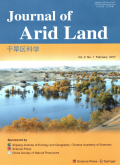- 钛学术文献服务平台 \
- 学术期刊 \
- 基础科学期刊 \
- 天文学、地球科学期刊 \
- 干旱区科学期刊 \
null
Comparing phreatic evaporation at zero water table depth with water surface evaporation
基本信息来源于合作网站,原文需代理用户跳转至来源网站获取
摘要:
Salt-affected soils are mostly found in irrigated areas within arid and semi-arid regions where the groundwater table is shallow.Soils of this type have become an increasingly severe problem because they threaten both the environment and the sustainable development of irrigated agriculture.A tool to estimate phreatic evaporation is therefore urgently required to minimize the salinization potential of salt-affected areas.In this context,phreatic evaporation at zero water table depth (E0) is a key parameter for establishing a model for calculating phreatic evaporation.The aim of this study was to explore the law of phreatic evaporation and to develop structurally rational empirical models for calculating phreatic evaporation,based on E0 data of six types of soil (i.e.,gravel,fine sand,sandy loam,light loam,medium loam,and heavy loam) observed using the non-weighing lysimeter and water surface evaporation (E601) data observed using a E601 evaporator of same evaporation area with a lysimeter-tube at the groundwater balance station of the Weigan River Management Office in Xinjiang Uygur Autonomous Region,China,during the non-freezing period (April to October) between 1990 and 1994.The relationship between E0 and E601 was analyzed,the relationship between the ratio of E0 to E601 and the mechanical compositions of different soils was presented,and the factors influencing E0 were discussed.The results of this study reveal that E0 is not equal to E601.In fact,only values of the former for fine sand are close to those of the latter.Data also show that E0 values are related to soil texture as well as to potential atmospheric evaporation,the ratio of E0 to E601 and the silt-clay particle content (grain diameter less than 0.02 mm) is negatively exponentially correlated,and that soil thermal capacity plays a key role in phreatic evaporation at E0.The results of this analysis therefore imply that the treatment of zero phreatic depth is an essential requirement when constructing groundwater balance stations to study the law of phreatic evaporation.

推荐文章
期刊_丙丁烷TDLAS测量系统的吸收峰自动检测
带间级联激光器
调谐半导体激光吸收光谱
雾剂检漏 中红外吸收峰 洛伦兹光谱线型
不同盐度、温度及光照对漂浮浒苔生理生态的影响
浒苔
盐度
温度
光照
生理生态
期刊_联合空间信息的改进低秩稀疏矩阵分解的高光谱异常目标检测
高光谱图像
异常目标检测 低秩稀疏矩阵分解 稀疏矩阵 残差矩阵
内容分析
关键词云
关键词热度
相关文献总数
(/次)
(/年)
引文网络
引文网络
二级参考文献 (9)
共引文献 (5)
参考文献 (21)
节点文献
引证文献 (0)
同被引文献 (0)
二级引证文献 (0)
1963(1)
- 参考文献(0)
- 二级参考文献(1)
1981(1)
- 参考文献(0)
- 二级参考文献(1)
1983(2)
- 参考文献(0)
- 二级参考文献(2)
1984(1)
- 参考文献(1)
- 二级参考文献(0)
1985(1)
- 参考文献(0)
- 二级参考文献(1)
1986(1)
- 参考文献(0)
- 二级参考文献(1)
1987(2)
- 参考文献(2)
- 二级参考文献(0)
1989(2)
- 参考文献(1)
- 二级参考文献(1)
1992(1)
- 参考文献(0)
- 二级参考文献(1)
1993(1)
- 参考文献(1)
- 二级参考文献(0)
1994(1)
- 参考文献(1)
- 二级参考文献(0)
1996(1)
- 参考文献(0)
- 二级参考文献(1)
1998(1)
- 参考文献(1)
- 二级参考文献(0)
2000(1)
- 参考文献(1)
- 二级参考文献(0)
2001(1)
- 参考文献(1)
- 二级参考文献(0)
2002(1)
- 参考文献(1)
- 二级参考文献(0)
2006(2)
- 参考文献(2)
- 二级参考文献(0)
2007(1)
- 参考文献(1)
- 二级参考文献(0)
2008(1)
- 参考文献(1)
- 二级参考文献(0)
2009(3)
- 参考文献(3)
- 二级参考文献(0)
2010(2)
- 参考文献(2)
- 二级参考文献(0)
2011(1)
- 参考文献(1)
- 二级参考文献(0)
2013(1)
- 参考文献(1)
- 二级参考文献(0)
2018(0)
- 参考文献(0)
- 二级参考文献(0)
- 引证文献(0)
- 二级引证文献(0)
引文网络交叉学科
相关学者/机构
期刊影响力
干旱区科学
主办单位:
中国科学院新疆生态与地理研究所
科学出版社
出版周期:
双月刊
ISSN:
1674-6767
CN:
65-1278/K
开本:
出版地:
新疆乌鲁木齐市北京南路818号
邮发代号:
创刊时间:
语种:
eng
出版文献量(篇)
793
总下载数(次)
0
总被引数(次)
2282
期刊文献
相关文献
推荐文献

 免费查重
免费查重










